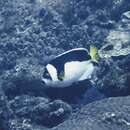en
names in breadcrumbs


Chaetodontoplus ballinae, the Ballina angelfish,[2] is a species of marine ray-finned fish, a marine angelfish, belonging to the family Pomacanthidae. It is endemic to eastern Australia.[3]
Chaetodontoplus ballinae Has a pearly-white body broken by a distinct black band which runs across the back and lower part of the dorsal fin, with the front part reaching down in a bar running over the base of the pectoral fin. The lips are black and there is a vertical dusky bar through the eye. The anal fin, the upper half of dorsal fin and the pelvic fins are white. The eye, front few spines in the dorsal fin, the caudal fin and the pectoral fin are yellow.[4] It attains a maximum length of 20 centimetres (7.9 in).[5]
Chaetodontoplus ballinae is endemic to the southwestern Pacific Ocean off the coasts of Eastern Australia. It has been recorded from widely separated localities including Stradbroke Island in southern Queensland, in northern New South Wales at Coffs Harbour, Ballina, Evans Head, North Solitary Island and Seal Rocks. It also occurs around Lord Howe Island in the Tasman Sea.[4]
Chaetodontoplus ballinae is found in subtropical areas at depths between 15 and 120 metres (49 and 394 ft).[6] It is found in deep coastal offshore reefs, as well as around sea mounts. They are relatively numerous in the vicinity of Balls Pyramid off Lord Howe Island. Here they may be observed in deeper habitats where there are large boulders, rock piles, peaks, caves and crevices.[4] Ball’s Pyramid is almost the only place where the Ballina angelfish has been photographed.[7] Little is known about the biology of the Ballina angelfish, although it has been recorded in pairs or as solitary fishes.[1]
Chaetodontoplus ballinae was first formally described in 1959 by the Australian ichthyologist Gilbert Percy Whitley (1903-1975), with the type locality given as off Ballina Bar in New South Wales.[8] The type locality is reflected in the specific name, ballinae.[9] The colour and patterning of the Ballina angelfish are unique within the genus Chaetodontoplus.[4]
Chaetodontoplus ballinae has been classified as Least Concern by the IUCN. [1] It does not appear in the aquarium trade as it has full legal protection in Australia.[7] It is subject to some bycatch by fisheries.[4]
Chaetodontoplus ballinae, the Ballina angelfish, is a species of marine ray-finned fish, a marine angelfish, belonging to the family Pomacanthidae. It is endemic to eastern Australia.
Chaetodontoplus ballinae Chaetodontoplus generoko animalia da. Arrainen barruko Pomacanthidae familian sailkatzen da.
Chaetodontoplus ballinae Chaetodontoplus generoko animalia da. Arrainen barruko Pomacanthidae familian sailkatzen da.
Chaetodontoplus ballinae is een straalvinnige vissensoort uit de familie van engel- of keizersvissen (Pomacanthidae).[2] De wetenschappelijke naam van de soort is voor het eerst geldig gepubliceerd in 1959 door Whitley.
De soort staat op de Rode Lijst van de IUCN als niet bedreigd, beoordelingsjaar 2009.[1]
Bronnen, noten en/of referentiesChaetodontoplus ballinae, thường được gọi là cá thần tiên Ballina là một loài cá biển thuộc chi Chaetodontoplus trong họ Cá bướm gai. Loài này được mô tả lần đầu tiên vào năm 1959.
C. ballinae chỉ được tìm thấy ở ngoài khơi thị trấn Ballina (phía bắc bang New South Wales) và đảo Lord Howe, đều thuộc lãnh thổ Úc. Chúng thường sống xung quanh các bãi đá ngầm và rạn san hô ở độ sâu khoảng 10 - 80 m, nhưng cũng có khi sâu hơn (100 - 120 m)[1][2].
Rất ít thông tin về loài này. Vì thế mà C. ballinae được cho là loài quý hiếm trong tự nhiên[2].
C. ballinae trưởng thành có thể dài khoảng 20 cm. Phần thân của C. ballinae có màu trắng xám với một dải màu đen khá rộng ở phần lưng đến cuống đuôi, kéo dài xuống gốc vây ngực. Phần trán có một đốm đen, trải dài tới mắt. Phần mõm cũng có một vòng màu đen. Vây đuôi và vây ngực có màu vàng tươi, các vây còn lại có màu trắng xám. Mống mắt có màu vàng[1][3].
Số ngạnh ở vây lưng: 11; Số vây tia mềm ở vây lưng: 22; Số ngạnh ở vây hậu môn: 3; Số vây tia mềm ở vây hậu môn: 21.
Thức ăn chủ yếu của C. ballinae có lẽ là những loài động vật giáp xác và rong tảo. C. ballinae thường sống đơn lẻ hoặc bơi thành cặp[1][2].
C. ballinae không có sẵn trong thị trường thương mại cá cảnh, nếu có thì mẫu vật của C. ballinae có giá khá cao[1][2].
Chaetodontoplus ballinae, thường được gọi là cá thần tiên Ballina là một loài cá biển thuộc chi Chaetodontoplus trong họ Cá bướm gai. Loài này được mô tả lần đầu tiên vào năm 1959.
水深100至120公尺。
本魚體卵圓形,吻圓鈍,口小;體色以白色為底,有一大塊黑色斑塊從背部沿伸體上半部至胸鰭基部,吻部及眼睛周圍也有黑色斑塊。眼經、胸鰭及尾鰭鮮黃色,背鰭及臀鰭軟條淺藍灰色邊緣。
本魚棲息在較深珊瑚礁區。
可做為觀賞魚。